| Nichollssaura Temporal range: Early Cretaceous, | |
|---|---|
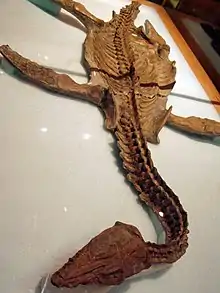 | |
| Holotype specimen at the Royal Tyrrell Museum | |
| Scientific classification | |
| Domain: | Eukaryota |
| Kingdom: | Animalia |
| Phylum: | Chordata |
| Class: | Reptilia |
| Superorder: | †Sauropterygia |
| Order: | †Plesiosauria |
| Clade: | †Leptocleidia |
| Family: | †Leptocleididae |
| Genus: | †Nichollssaura Druckenmiller & Russell, 2009 |
| Species: | †N. borealis |
| Binomial name | |
| †Nichollssaura borealis (Druckenmiller & Russell, 2008 [originally Nichollsia, preoccupied]) | |
| Synonyms | |
|
Nichollsia borealis Druckenmiller & Russell, 2008 | |
Nichollssaura is an extinct genus of leptocleidid[1] plesiosaur from the Early Cretaceous Boreal Sea of North America. The type species is N. borealis, found in the early Albian age Clearwater Formation near Fort McMurray, Alberta, Canada.[2]
Taxonomy
The fossil, named after paleontological curator Dr. Betsy Nicholls, originally was named Nichollsia borealis[3] but Nichollsia was already in use (preoccupied) by a genus of isopods. Thus, the original authors proposed Nichollssaura as a replacement generic name in 2009.[4]
Description

Nichollssaura was a small plesiosaur, reaching 2.5–3 m (8.2–9.8 ft) in length and 80 kg (180 lb) in body mass.[5][6][7] It fills an approximate 40-million-year gap in the fossil record of North American plesiosaurs.
The type specimen was discovered in one of Syncrude Canada Ltd.'s open-pit oilsand mines near Fort McMurray, Alberta, in 1994. The fossil is on display at the Royal Tyrrell Museum of Palaeontology, missing only the left forelimb and scapula, lost when the specimen was discovered accidentally by 100-ton electric shovel operators Greg Fisher and Lorne Cundal.[8]
Classification
Nichollssaura in a cladogram based on Ketchum and Benson (2011):[9]
| Leptocleididae |
| ||||||||||||||||||||||||
See also
References
- ↑ Ketchum, H. F. & Benson, R. B. J. (2010). "Global interrelationships of Plesiosauria (Reptilia, Sauropterygia) and the pivotal role of taxon sampling in determining the outcome of phylogenetic analyses". Biological Reviews. 85 (2): 361–392. doi:10.1111/j.1469-185X.2009.00107.x. PMID 20002391. S2CID 12193439.
- ↑ Henderson, D. (2013). "A one-in-a-billion dinosaur find". The Guardian. Retrieved 2013-11-21.
- ↑ Druckenmiller, P.S.; Russell, A.P. (2008). "Skeletal anatomy of an exceptionally complete specimen of a new genus of plesiosaur from the Early Cretaceous (Early Albian) of northeastern Alberta, Canada". Palaeontographica Abteilung A. 283 (1–3): 1–33. doi:10.1127/pala/283/2008/1.
- ↑ Druckenmiller, Patrick S.; Russell, Anthony P. (2009). "The new plesiosaurian genus Nichollssaura from Alberta, Canada: replacement name for the preoccupied genus Nichollsia". Journal of Vertebrate Paleontology. 29 (1): 276. doi:10.1080/02724634.2009.10010379. S2CID 83847722.
- ↑ Valentin Fischer; Nikolay G. Zverkov; Maxim S. Arkhangelsky; Ilya M. Stenshin; Ivan V. Blagovetshensky; Gleb N. Uspensky (2020). "A new elasmosaurid plesiosaurian from the Early Cretaceous of Russia marks an early attempt at neck elongation". Zoological Journal of the Linnean Society. 192 (4): 1167–1194. doi:10.1093/zoolinnean/zlaa103. hdl:2268/251614.Supplementary Information
- ↑ Paul, Gregory S. (2022). The Princeton Field Guide to Mesozoic Sea Reptiles. Princeton University Press. p. 119. ISBN 9780691193809.
- ↑ Benson, R. B. J.; Ketchum, H. F.; Naish, D.; Turner, L. E. (2012). "A new leptocleidid (Sauropterygia, Plesiosauria) from the Vectis Formation (Early Barremian–early Aptian; Early Cretaceous) of the Isle of Wight and the evolution of Leptocleididae, a controversial clade". Journal of Systematic Palaeontology. 11 (2): 233–250. doi:10.1080/14772019.2011.634444. S2CID 18562271.
- ↑ "PALAEOBLOG". palaeoblog.blogspot.com. 20 March 2008.
- ↑ Ketchum, Hilary F.; Benson, R. B. J. (2011). "A new pliosaurid (Sauropterygia, Plesiosauria) from the Oxford Clay Formation (Middle Jurassic, Callovian) of England: evidence for a gracile, longirostrine grade of Early-Middle Jurassic pliosaurids". Special Papers in Palaeontology. 86: 109–129.
External links
- "New "Sea Monster" Species Identified". National Geographic. Archived from the original on February 8, 2012.
- Michael J. Ryan, Ph.D. "Betsy's Plesiosaur, Nichollsia borealis". Palaeoblog. Archived from the original on June 5, 2023.
- "Details on "Nichollsia" borealis". ScienceBlogs. Archived from the original on April 4, 2008.
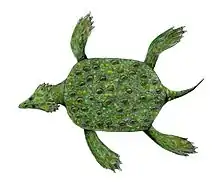
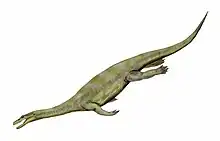
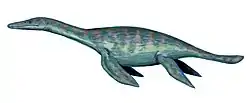

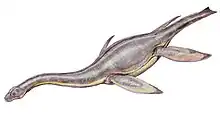

.png.webp)